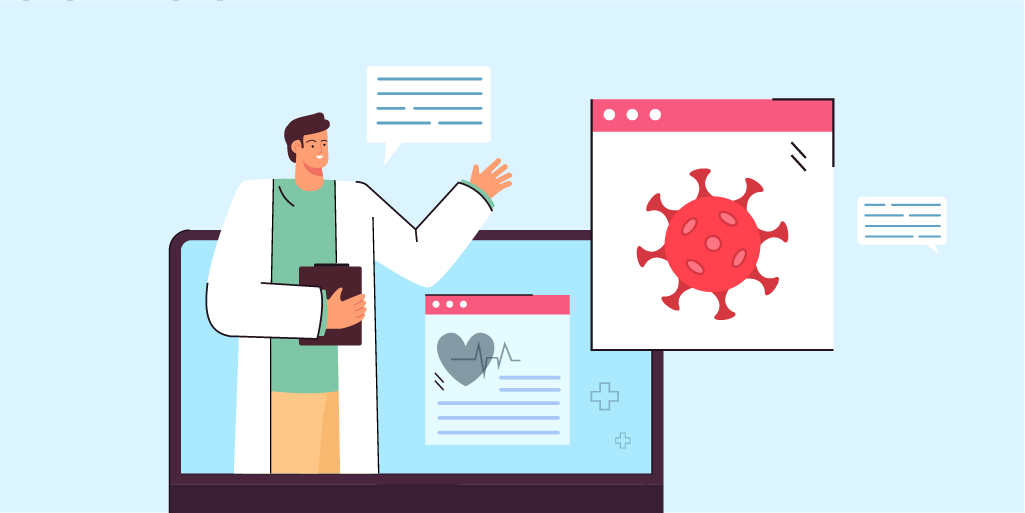GOT A UI/UX
DESIGN PROJECT?
Telehealth and It’s Impact on Covid-19

Before the pandemic, going to a doctor for anything required planning and multitasking. It usually meant taking some time away from work, from home, or just making some time in your day to plan and see the doctor. But during the pandemic, going to a doctor in person became an almost impossible task. Hospitals became high-risk spaces that were catering to the most seriously affected by the pandemic. Such a situation strongly warranted the question – what is the alternative to the traditional medical consultation route? It’s certainly not physically seeing a doctor. The answer came to everyone in the form of something that already existed but was never the first option. The option was virtual consultation or telehealth.
What is Telehealth?
“Telehealth is the distribution of health-related services and information via electronic information and telecommunication technologies. It allows long-distance patient and clinician contact, care, advice, reminders, education, intervention, monitoring, and remote admissions.”
Early in the COVID-19 pandemic, telehealth usage surged immensely as consumers and providers sought ways to safely access and deliver healthcare since they couldn’t make it to the doctor in person. In April 2020, overall telehealth utilization for office visits and outpatient care was 78 times higher than in February 2020.

What caused the change?
This drastic change, no doubt, was borne out of necessity. It was, however, fueled by these factors:
- increased consumer willingness to use telehealth because of the unavailability of traditional methods.
- increased provider willingness to use telehealth as they could consult with patients on their own time and provide their expertise and opinions.
- regulatory changes enabling greater access and reimbursement, which allowed for a higher amount of trust.
During the tragedy of the pandemic, telehealth offered a bridge to patient care and now offers a chance to reinvent virtual and hybrid virtual/in-person care models, with a goal of improved healthcare access, outcomes, and affordability.
The uptake of telehealth doesn’t mean telemedicine completely replaced in-person care: The increase in telemedicine only offset about 40% of the decline in in-office visits. Doctors see telehealth as beneficial for patients, who save on time and travel, as well as for physicians, who can reach a geographically wider population.
The question we need to address is how can telehealth services be improved if they’re here to stay?
So let us look at a few fundamental things that can be implemented to help telemedicine be effective in the long term as a viable option, and not just an alternative to traditional in-person doctor relationships.
Improvement of Telehealth Services
Real-time Communication

Real-time communication makes use of any communication technologies to contact the patient. Video conferences, live chats, voice messages, and emails are the primary examples.
Store and Forward Health Reports

Store and forward entails collecting direct patient data and forwarding it to the relevant specialist. This data can be a recording of an appointment or a test result. It is then placed in a single file to be stored in a database of an Electronic Health Record (EHR) system.
Tele-Monitoring or Remote Patient Monitoring

Remote patient monitoring or RPM is a practice within telemedicine aimed at monitoring the vital statistics of the patients remotely. Telemonitoring relies on different electronic devices that stream patients’ statistics right to a healthcare provider’s analytical interfaces like Ultrasound imaging or Tele-stethoscopes. This way, healthcare providers can analyze the state of a patient, receive precise data about symptomatology, store the test results, and use them in the future.
Mobile Health or mHealth

People often use mobile health applications to access telemedicine support. Generally, mobile applications connect an electronic clinical device with software. But they can also act as a standalone tool.
The ease of distributing mobile applications on the AppStore and Play Market makes mHealth a fast-growing technology. Using mobile apps for various tasks, a hospital can optimize the use of its space, speed up communication, share more data, and conduct some clinical procedures remotely.
Many healthcare systems around the world together with government agencies and startup companies are building and delivering Telehealth solutions — the future of non-emergency and routine healthcare delivery.
Doctors are happy with telehealth, while patients are now expecting it since it is a great avenue for care.
Read the entire project story of Vidal Health, a telehealth app. If you’re curious, this is what it takes to design for a telehealth platform.
